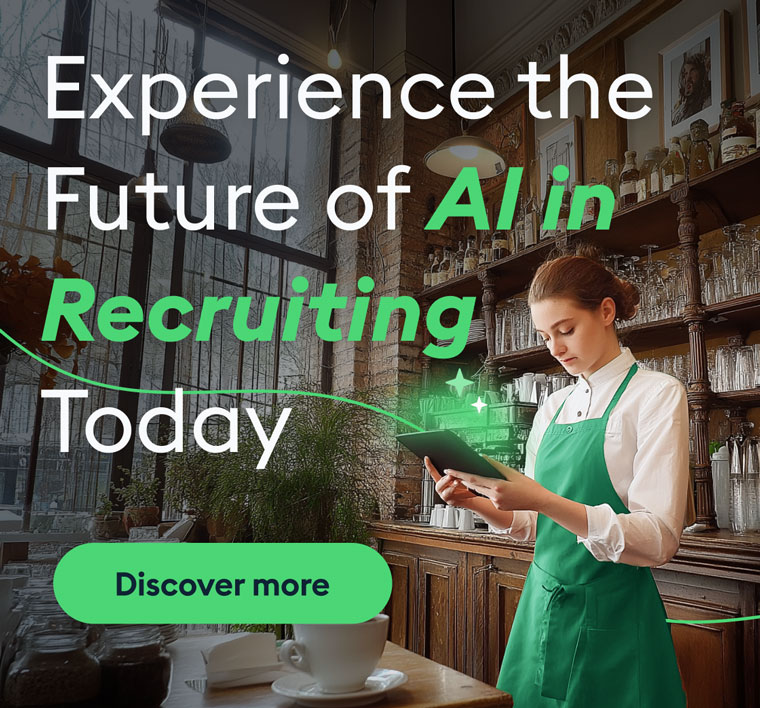The New Hiring Process: Part Human, Part Automation
Hiring Success GlossaryThe process of hiring a new employee involves finding, engaging, evaluating, and selecting, and onboarding ideal candidates for an open job. New technology, especially artificial intelligence, is reshaping many steps of the hiring process. This article describes the essential steps of the hiring process and discusses how they are being impacted by AI and automation.
What is a hiring process?
An efficient and effective hiring process involves a step-by-step method for hiring a new employee. An organization identifies its talent needs, recruits from its talent pool as well as looks externally, screens and assesses candidates, and makes a selection.
Most companies have developed their own hiring processes over time, so the steps can vary quite a bit depending on the organization and the role. What follows are the most common steps in the hiring process across industries and regardless of company size. It also describes how AI is influencing the hiring process at different stages.
15 Steps of the Hiring Process
1. Identify the hiring need
The hiring process begins by identifying a need within your organization. This need could vary from filling a vacated position, better managing a team’s workload, or expanding the reach of organizational tasks. Positions are, in other words, either newly formed or recently vacated. Some organizations have started using AI in this process. The technology can provide information on the labor market, identify skills needed in various jobs, and help companies decide what skills they need to fill the gap.
2. Devise a recruitment plan
Once an organization identifies a hiring need, it should begin recruitment by developing a plan. In the case of newly formed positions, organizations should look at how the new role aligns with their goals and business plan. Organizations should ensure that relevant employees are aware of the new position and their responsibilities at the relevant stages of the hiring process. Hiring is most effective when everyone involved in the hiring decision agrees to the hiring process, the steps taken to publicize the job, the candidate selection criteria, and the interview process.
3. Build a job description
Once the candidate criteria are defined, the recruitment team then generates a job description that includes a list of job requirements, preferred skills and characteristics, and requisite experience. The job description also typically includes information regarding salary and benefits. Templates are available to build job descriptions. Generative AI helps companies build job descriptions that hone in on necessary skills and avoid the bias that comes with vague phrases (“looking for a passionate go-getter”) that have traditionally found their way into job descriptions.
4. Use your talent pool
A candidate relationship management (CRM) system helps with identifying highly-qualified potential candidates who are already interested in your organization. This technology helps build a pool of past applicants, employee referrals, former employees, current employees, and contractors who could be ideal candidates for a job. Ideally, this system operates natively with your applicant tracking system, avoiding integration challenges. Searching the CRM and notifying potential candidates is an essential step in the hiring process for companies that use this technology.
5. Advertise the job
Recruitment advertising is getting smarter and easier. You can post to hundreds of job boards with one click. Data-driven technologies now help you monitor the success of your advertising. There are more advertising options than ever, including your own company’s website, social media platforms, job boards, career fairs, and events.
6. Recruit for the position
Your hiring team, including recruiters, managers, and even potential co-workers of the new hire, should contact potential candidates or use social media to mention the job opening to their contacts. Contact can be made via email, phone, and social media platforms such as LinkedIn.
7. Screen the applications
For decades, recruiters have sifted through applications, first on paper and later digitally reviewing resumes, to find the ideal candidates to interview. Now, AI assistants can rapidly screen new and existing resumes. AI-assisted matching can also help make faster, smarter, and more objective selection decisions because it is programmed to be unbiased.
Once top applications have identified, the process often moves to a phone interview screening. With AI technologies handling much of what was traditionally done during these cursory screens, the conversations can now revolve around “selling” the job and answering questions, as opposed to uncovering basic information such as salary expectations, ideal start dates, or location preferences.
8. Interview candidates
Depending on the size of the organization and hiring committee, one or several interviews are scheduled for the candidates who passed the phone screen. Early interviews are typically one-on-one, in-person interviews between the applicant and the hiring manager. They typically focus on applicants’ experience, skills, work history, and interest in the organization.
Additional in-depth interviews with management, staff, executives, and other members of the organization can be either one-on-one or group interviews with the hiring committee.
The interview stage may be a good point in the hiring process to inform the candidates you elect not to interview that they are no longer under consideration. New tools are available to assist you with templates and with sending disposition emails in bulk.
Final interviews for a shortlist of candidates often include conversations with the company’s senior leadership or another discussion with an interviewer from an earlier stage in the hiring process.
9. Applicant assessment
Not all positions require assessments. If an assessment has been determined necessary to better qualify candidates for the role, it can take place at a variety of points in the hiring process, such as before the phone screen or after the first interview. Assessments measure a wide range of variables, such as coding skills, writing skills, mathematics, emotional intelligence, customer service, and IQ. Assessments can include a skills test, an assignment, or a presentation to a group.
10. Background check
Your initial job posting should indicate that all candidates are subject to a background check, which has been made quicker and easier with service provider technologies that link with the applicant tracking system. Background checks should be completed as allowed under state and federal law, as advised by your attorney. Drug testing may also be needed, depending on the job.
11. Hiring decision
After background and reference checks, the hiring team identifies its top choice. The team should also select a backup candidate in case the top choice declines the offer or negotiations fail. If no candidates meet the hiring criteria, the hiring team should determine whether to start the hiring process over, perhaps making adjustments to yield more qualified candidates.
12. Reference check
Reference checks, if done, should verify information shared by the candidate about previous employment, such as job performance, experience, responsibilities, and workplace conduct. A typical question to ask is, “Would you rehire this person?” A variety of new technologies make this process easier by sending simple surveys by email or text to references.
13. Job offer
Once a top candidate is identified, the organization should extend an initial offer. The offer letter should include salary, benefits, time off, start date, a remote or in-person work policy, company equipment that is provided, and other terms and conditions. The hiring staff should determine internally which elements of the offer letter are negotiable (typically salary and work schedules). Offers are another area that has been streamlined and automated.
14. Hiring
After negotiations, once the candidate accepts the job offer, they are hired. An accepted offer letter leads to paperwork related to employment. Forms and paperwork might include tax forms, immigration-related forms, and employee handbooks.
15. Onboarding
Onboard your new worker in a professional way. The first weeks on the job lay the groundwork for a long-term productive relationship between the new hire and your company. The manager or a co-workers should reach out to the employee (without using too much of the new hire’s time before they have even started) before their start date to welcome them. Deliver training in a structured way and set clear expectations for the first days on the job. If an orientation is part of the onboarding, make sure your employee has a clear understanding of the expectations and scheduling of those events. Consider assigning your new employee a mentor to help them learn more about the organization.
The hiring process transformed
The hiring process is being changed by technology. AI companions and other advanced technologies are helping to automate the manual and tedious parts of the recruiting process, freeing up recruiters to spend more time with job candidates and managers, better understand the business, and review analytics. Humans will always play a significant role in hiring other humans, and technology will help them do it even more efficiently.



